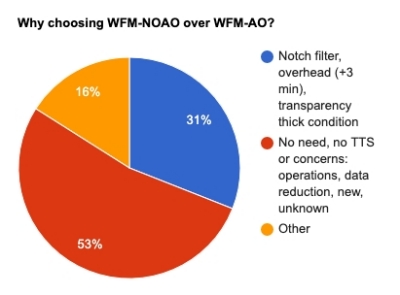MUSE WFM users are reminded that MUSE Wide Field Mode with Adaptive Optics is more efficient and suitable than non-AO for most science cases. Until now, a large fraction of MUSE observations were taken in Wide Field Mode without Adaptive Optics (NOAO) for a mixed bag of reasons as testified by the results of an ESO-led survey to over 190 MUSE previous PIs (see the figure above).
Astronomers are Encouraged to Use the MUSE Wide Field Mode with Adaptive Optics

While the NOAO mode is essential for programmes gathering information over the 582 - 597 nm wavelength which is otherwise blocked by the Na Notch filter, the benefits of AO are many-fold. Not only AO operations at the telescope have become routine, but more importantly, image quality of AO supported cubes is consistently improved under all observing conditions - including poor seeing, light cirrus, or high wind speeds - and the performance remains stable during long exposure times. In case no Natural Guide Star is available, the so-called Tip-Tilt free mode uses the telescope field stabilisation still providing a significant improvement on image quality. That is, AO benefits are available without the need for a tip-tilt star. In addition, the pipeline processes AO and non-AO data equally well. Because of the benefits discussed above, shorter exposure times are required in AO mode to reach equivalent image quality. In P116 the demand for MUSE WFM AO mode has increased and more future Programs are likely to benefit from using AO in WFM.
